Pruning roses in the fall for beginners for the winter
- Before starting work, you need to prepare the tool:
- garden pruner;
- garden saw for removing thick branches;
- var for covering up wounds from cuts.
The pruner and saw should be sharp to get a smooth cut. Wear thick gloves to protect your hands from thorns.
The branches must be cut at an angle of 45 degrees, at a distance of half a centimeter from the bud. It is necessary to take into account which side of the branch is the bud under the cut, because it is from it that a new shoot will begin to grow in the spring. Avoid pruning a branch over a bud that looks inward or downward.
The cut with the pruner should be done in one sharp motion, without leaving tatters of bark on the branches.
The wound on the shoot must be treated with garden varnish, wax or special glue. Moisture will get on an unprotected cut, microbes and the branch will begin to rot.

Sanitary pruning
The bush gets rid of weak, sick and damaged shoots. Extra branches are removed, leaving no more than 7 shoots on the plant. Make sure they are evenly spaced on the bush.
The florist needs to imagine how a bush covered with leaves will look in spring, and leave those shoots that do not shade the crown.
Anti-aging pruning
A short haircut, in which all branches are removed under the root, over 3 years old. If the bush has not been processed for a long time and all its shoots are old, they are shortened as much as possible, leaving 2-3 buds on the stumps.
Pruning roses before planting
When planting rose seedlings in autumn, their shoots are cut as short as possible, leaving no more than 3 buds on a branch. This will help the plant adapt more easily to the new location.
If the rose has an open root system, it is recommended to cut its roots by 3-5 cm to stimulate the growth of lateral roots.
Correct pruning of a young rose bush
In the first year of planting a rose bush, it is pruned rather shortly for the winter. In addition to removing weak branches, strong shoots are shortened to 14 cm. This type of pruning allows a young plant to successfully overwinter, covered with a completely insulating material.
Short pruning is not applicable to park and ground cover varieties of roses.
After flowering
To preserve the strength of the plant, all wilted buds, together with a part of the stem of 8-10 cm, are removed from the bush. Unopened buds that have formed on the rose too late are also cut off.
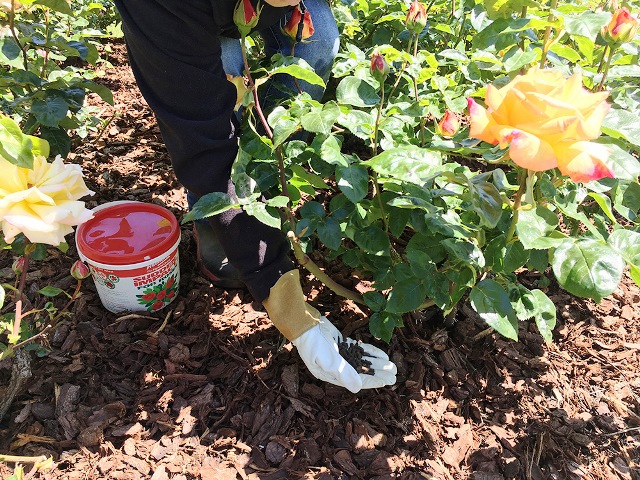
Basic pruning of indoor roses
Indoor roses are pruned to stimulate thickening of the bushes and as abundant flowering as possible according to the same principles and rules as any other cultivated bush roses, including garden roses. Shortening all old shoots to stimulate new growth is a major challenge. It is impossible to stimulate the growth of strong, healthy and high-quality young shoots without pruning: indoor queens bloom on the shoots of the current year, and without pruning, flowering will be very scarce.
Basic pruning of indoor beauties is carried out after a period of rest and before the start of active growth. Usually roses are pruned in February or early March. But it is best to focus on a much more obvious sign - swelling of the kidneys. They should not wake up, begin to develop, but only "turn up" so that it is easy to recognize future growth points. The duration of daylight hours at the time of pruning should already exceed 10 hours.
For indoor roses, both late and early pruning are equally dangerous:
- if pruning is carried out ahead of time, during a short daylight hours, then new shoots will develop too weakly, and both foliage and flowering will suffer;
- if pruning is done late, when growth begins to develop from the buds, then as a result of a cardinal shearing, growth will stop, the plant will spend energy on adaptation, and all development before pruning will be "wasted" and deplete the plant.
Indoor rose in pots. Andrea Satterfield
The main pruning begins not with a general regulating pruning, but with a mandatory sanitary cleaning. This procedure is typical for all shrubs in both garden and indoor culture:
- First of all, remove all damaged, dry shoots. Pruning is carried out to healthy tissue. If there is no point in preserving the rest of the shoot (for example, if there are no buds on it), then they are pruned to the ground.
- All weak, elongated, thinned shoots are cut to the base.
- The bushes are carefully examined and the branches are cut to the base, thickening the crown and growing inside the bushes. During trimming, you also need to remove:
- strongly curved shoots;
- twigs without an upper central bud (stubs);
- one of any overlapping shoots and extra twigs growing from a single bud.
If pruning was carried out after flowering, then before the main pruning, they just cut out previously missed or new problem areas, carry out control.
The most reliable rule, which allows you to always prune a rose correctly, is to cut all the shoots to half their length. If you have no experience of growing roses in a room culture, or you are afraid of pruning, then apply this particular pruning principle. This is the safest way to cut indoor roses.
If pruning does not scare you, and you can easily navigate in the plant itself, you can “count” the buds well and adjust the pruning individually on each bush, then it is better to use a less versatile, but also more productive strategy. All shoots of a room rose are shortened, leaving at least 3 high-quality buds on them (the optimal number is 4-5 buds). The degree of pruning is determined depending on the desired compactness and shape of the bush, the condition of the plant, the thickness and height of the shoots. Small-flowered roses like a lower pruning than large-flowered ones, low-growing shoots are cut into three buds, and up to 5-6 buds can be left on powerful ones. On any bush, it is imperative to leave 4-5 strong skeletal shoots (they are usually shortened to 3-5 buds, leaving a base 10-15 cm high).
The formation of a rose can be carried out at will. When pruning roses, you can set a strict, almost topiary shape of a ball or cone, you can limit the height or make the bushes "flat". Different types of roses are more "prone" to their particular shape. So, floribundas and Chinese (Bengal) indoor roses are formed at will, miniature roses are often grown in a spherical, conical or elliptical shape. If the rose was bought with a certain shape of the bush, then with regular pruning it is supported and the escaping shoots are shortened. If they want to set a new shape for a room rose, then it is better to carry out the formation gradually and stretch it over several years, cutting off only part of the shoots every year and giving the plant time for high-quality thickening of the crown and restoration.
In addition to the main pruning, roses are worth keeping an eye on throughout the rest of the year. If some shoots grow unproductively, are too weak or thin, stretch out, stand "naked", it is better to remove them immediately.
Features of the formation of a rose bush
The formation and pruning of roses is carried out in order to grow a plant with an optimal crown, characterized by strength and ease of care, as well as ensuring an even distribution of side shoots, buds and flowers.
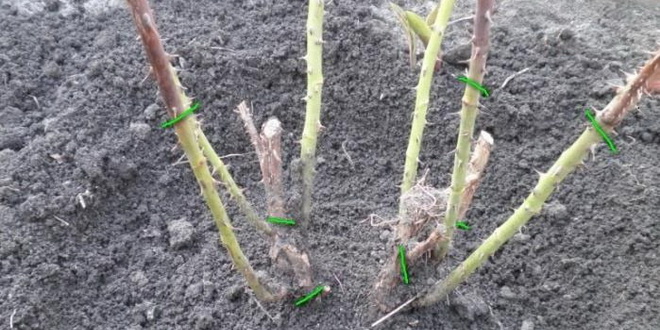
The features of shaping pruning are as follows: when 3-4 leaves grow on the grafted shoot, pinch the top of the shoot to stop its growth, thanks to this, axillary buds are quickly formed, which will give rise to new shoots of the bush. It is necessary to strive to ensure that branching begins as low as possible, best of all from the buds at the root collar
This is especially important in central Russia, where in cases of freezing of the bushes there is a high probability that the lower buds, covered with snow, will remain and a highly productive bush can be formed from them again.
Pruning is the most important technique in the rose growing system; it regulates the growth of plants, promotes the constant rejuvenation of the bushes, successful fight against pests and diseases, prolongs the life of the rose, promotes better wintering.

Correct pruning of roses, first of all, must satisfy the goals and objectives for which these noble flowers are grown. For example, roses grown to decorate a summer cottage are pruned differently than in the areas where they are grown for cutting or sale. In the conditions of central Russia, spring, summer and autumn pruning is carried out. Spring pruning is most important for roses. Its main task is to remove frost-damaged shoots, which leads to more intensive growth and flowering of roses. The best time for spring pruning is before bud break.
The formation of a rose bush in summer is carried out after the end of the first flowering and continues throughout the entire flowering period. With this pruning, all shoots thickening the center of the bush are removed, mostly blind shoots (without flowers) and fatty ones. In varieties that bloom 2-3 times per season, remove inflorescences and faded flowers.
Autumn pruning. Its main task is to prepare roses for winter. In the middle lane, it is usually carried out in late October - early November.
With this pruning, all unresolved leaves, weak, unripe shoots and remaining flowers and fruits are removed. Vigorous varieties of roses (floribunda, grandiflora, hybrid tea) are pruned so that they can be easily covered.
Beautiful examples
Consider some interesting examples of how to beautifully place roses on your site.
You can surround yourself with roses in the following way: create an arch of burgundy climbing varieties and plant next to varieties of other shades. An elegant table and chairs will complete the composition. In such a corner it is pleasant to spend both morning and evening hours with a cup of coffee or tea. Everything is filled with harmony and tranquility. The best relaxation you can imagine.
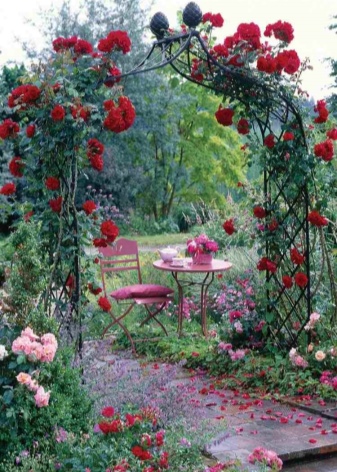
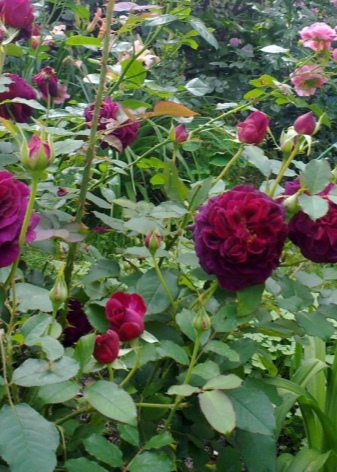
Burgundy bushes look very organic along well-groomed paths. They emphasize the severity and beauty of the surrounding area. Other green spaces are a good addition to roses. The main thing is that in the immediate vicinity there are no trees that are too tall, which will block the access of light to the roses, which they need for good flowering.
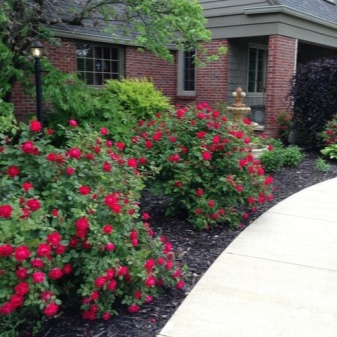

A wonderful decoration of the garden will be a corner where roses, conifers, various types of herbs, stones are combined. It always looks stylish and interesting. An artificial reservoir or a small fountain will be a good addition to such a corner.

See the video below for the features of the Red Naomi variety.
5 Popular varieties
Climbing roses have many interesting highly decorative varieties.
Climbing roses Rosanna, Laguna, Jasmine are successfully grown in the northern gardens. They bloom fully twice a season, and in warm autumn they can bloom for the third time. These varieties belong to the Climber group, have thick stems and do not need support, therefore they are suitable for beginner gardeners. Climbers bloom in large flowers several times per season on the shoots of the past and current year. There are also once-flowering varieties.
Description of the listed varieties:
- Roseanne - flower diameter up to 11 cm, the shape resembles hybrid tea varieties. The color is pink with a coral tint. Very hardy.
- Lagoon - bright pink double flowers are collected in 6-8 pieces. Has a strong fruity odor.
- Jasmine is an abundant plant with pink double flowers and a sweet scent.
Roses are not judged by their first bloom. Even the most first-class seedling still takes root in the first year, therefore it forms smaller and more beautiful buds than stated by the manufacturer. Abundant flowering of a rose can only be expected in the second year.
Setiger hybrids are a popular cultivator group in Russia. All plants from this group belong to the Kleimer type, have long whip-like shoots and large flowers.
Baltimore Belle - flowers up to 5 cm in diameter, double, pale pink, bright pink buds. It blooms late, but very effectively and long-lasting (up to 30 days). There is no second flowering. In a closed form, they tolerate frosts down to -30 degrees, they are almost not affected by powdery mildew.
Erignerunsh An Brod - flexible, spreading shoots with lush green foliage, which are covered with purple-violet sweet-smelling flowers twice a season, collected in inflorescences of 5-9 pieces. The diameter of each flower is up to 8 cm. The flowers are densely doubled, similar to old roses. This variety is the progenitor of many modern varieties with purple flowers. In warm climates, the plant can bloom a third time. When closed it can withstand frosts down to -35 degrees.
Baltimore Belle
The table shows the best varieties of Rambler:
|
Name |
Description |
|
Excelsa |
Small carmine flowers are collected in large clusters. Scourges reach 4.5 meters in length, the shoots are flexible. Suitable for decorating cold walls, trees, low hedges. Delivers poor soil and shade. It is formed as a curly, ground cover and weeping standard rose. It blooms profusely and for a long time, odorless. Single flowering |
|
Dorothy Perkins |
The flowering is very abundant. Cascades of pink flowers hang from the plant. Scourges reach 3 meters in height. Suffers from powdery mildew. Terry flowers, up to 6 cm in diameter. Suitable for growing on a trunk, for vertical gardening. Winter hardy |
|
Amethyst |
Bred in France in 1911, but still popular for its beauty. The flowers are pale purple in color with white streaks on the petals. Immediately after blooming, the flowers are beautiful and neat, and then become fluffy, disheveled. Inflorescences are large, conical, looking up |
|
White Flight |
The flowering bush is almost completely covered with large clusters of white semi-double flowers. In unopened form, the flowers are creamy pink, after blooming, the petals become dazzling white, and then greenish. Liana length - up to 4 meters, flower diameter - up to 4 cm. Single flowering |
|
Elise |
Flowers are bright pink with a light core, non-double, collected in numerous inflorescences. It blooms twice a season. Flower size - up to 4 cm, lash length - up to 3 m.Resistant to powdery mildew and rain |
|
Adzhimushkay |
Shoots up to 2 meters long, flexible, densely leafy. The flowers are very large, double, with a rosehip smell, collected in inflorescences of 5 pieces. The color is rose red and blood red. The variety is suitable for vertical gardening |
|
Red parfum |
The variety was bred in France in 1972. He has flowers of a classical form, rare for Rambler. Ruby color, strong aroma. Flowers are solitary or collected in small clusters. This is one of the best varieties of climbing roses, as it blooms profusely and is a little sick. The length of the lash is up to 4 m. The variety is suitable for arranging arches. It blooms twice. The second bloom is more abundant than the first. Reacts well to feeding |
|
Galia |
Delicate pink semi-double flowers. Blooms profusely, long, vigorous bushes. Winter-hardy and disease-resistant variety. The origin is unknown. It is assumed that the variety originated from the old Rambler |


